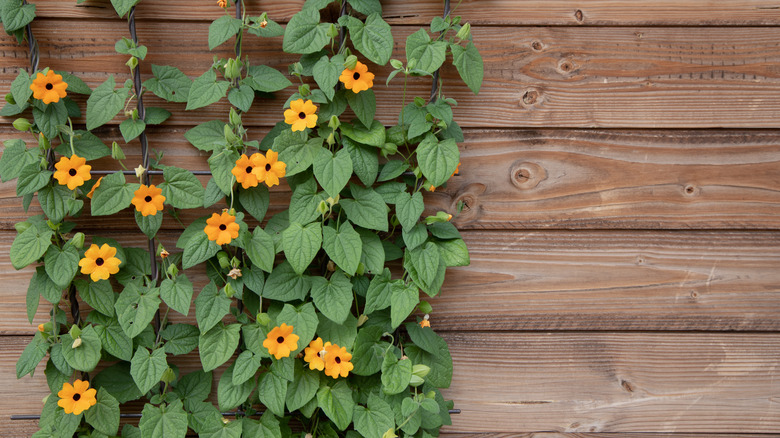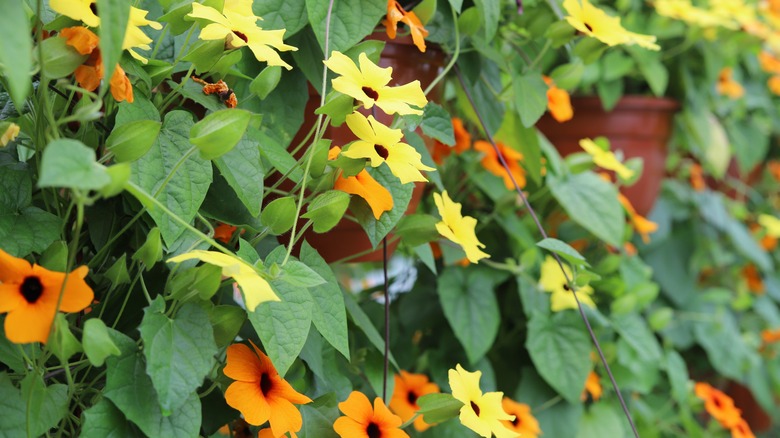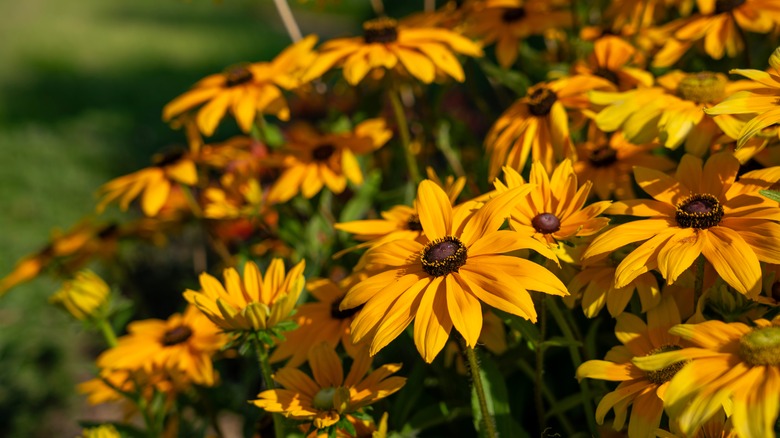The Downside To Growing Black-Eyed Susan Vines Around Your Garden
The beautiful black-eyed Susan vine can quickly bring color and vertical interest to gardens and trellises thanks to its beautiful flowers and fast growing nature. In many locations it's a plant lover's dream thanks to its ability to quickly cover structures and attract pollinators like hummingbirds and bees. Unfortunately, for gardeners in U.S. growing zones 10 and 11 it can quickly turn into an invasive nightmare.
Despite the confusing name, the black-eyed Susan vine (Thunbergia alata) is not closely related to the North American wildflower called black-eyed Susan (Rudbeckia hirta) and is instead a tropical vine native to eastern and southern Africa. Black-eyed Susan vines are fast-growing annuals in zones 8 or lower, but in frost free areas where they are perennial, they can quickly become invasive. While some sources, including The University of Wisconsin Madison, state the vines can also perennialize in zones 9, other sources, including The North Carolina State Extension, only consider that a risk in zone 10 or higher. In light of the conflicting information, gardeners in zone 9 should definitely watch these vines carefully for signs of invasiveness if they opt to grow them. Here's what to know about black-eyed Susans before planting.
Growing black-eyed Susan vines
Black-eyed Susan vines can be an excellent option for gardeners in colder climates. The vines grow and flower fast enough to provide an impressive show all summer, and then the frost kills the vine, preventing it from surviving the winter and becoming invasive. Self-seeding is a potential issue, but as the flowers set seed relatively late, they may be killed off by frost before going to seed.
Black-eyed Susan vines can be easily started from seeds which can be either directly sowed after the last frost or started inside and transplanted out. They can also be purchased as young plants. Plant your black-eyed Susan vine in an area that receives at least part sun and has well-draining soil and plenty of organic material. Because black-eyed Susan vines are climbers, they do best with a trellis or other structure. These can be purchased at garden centers or you can DIY a strong garden trellis with items you may already own.
Alternatives to black-eyed Susan vines
Considering the black-eyed Susan vine's invasive potential in some regions, you should think carefully before planting it and look at some North American native plants that can fill similar niches in your garden. For gardeners who appreciate the black-eyed Susan vine's ability to quickly cover trellises and attract pollinators, the trumpet vine adds color and attracts hummingbirds to your yard thanks to its bright orange flowers. Hardy in zones 4 through 10, it grows well with full or part sun and can thrive even in poor soil.
American wisteria is also an excellent option for anyone looking for native flowering vines. Far less aggressive than its invasive relatives Chinese and Japanese wisteria, it is a hardy perennial in zones 5 through 9 and grows well in full sun or part shade locations with well-draining and acidic soil. Of course, for anyone who is primarily attracted to the black-eyed Susan vine because of its beautiful flowers, the easiest solution may be to simply grow black-eyed Susans. While they are not vining, the perennial wildflowers grow well in zones 3 through 8 and are impressively drought tolerant once established. They thrive in full and partial sun locations and are adored by native butterflies and songbirds.


